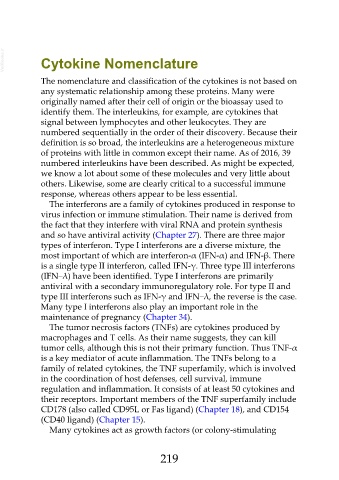Page 219 - Veterinary Immunology, 10th Edition
P. 219
VetBooks.ir Cytokine Nomenclature
The nomenclature and classification of the cytokines is not based on
any systematic relationship among these proteins. Many were
originally named after their cell of origin or the bioassay used to
identify them. The interleukins, for example, are cytokines that
signal between lymphocytes and other leukocytes. They are
numbered sequentially in the order of their discovery. Because their
definition is so broad, the interleukins are a heterogeneous mixture
of proteins with little in common except their name. As of 2016, 39
numbered interleukins have been described. As might be expected,
we know a lot about some of these molecules and very little about
others. Likewise, some are clearly critical to a successful immune
response, whereas others appear to be less essential.
The interferons are a family of cytokines produced in response to
virus infection or immune stimulation. Their name is derived from
the fact that they interfere with viral RNA and protein synthesis
and so have antiviral activity (Chapter 27). There are three major
types of interferon. Type I interferons are a diverse mixture, the
most important of which are interferon-α (IFN-α) and IFN-β. There
is a single type II interferon, called IFN-γ. Three type III interferons
(IFN−λ) have been identified. Type I interferons are primarily
antiviral with a secondary immunoregulatory role. For type II and
type III interferons such as IFN-γ and IFN−λ, the reverse is the case.
Many type I interferons also play an important role in the
maintenance of pregnancy (Chapter 34).
The tumor necrosis factors (TNFs) are cytokines produced by
macrophages and T cells. As their name suggests, they can kill
tumor cells, although this is not their primary function. Thus TNF-α
is a key mediator of acute inflammation. The TNFs belong to a
family of related cytokines, the TNF superfamily, which is involved
in the coordination of host defenses, cell survival, immune
regulation and inflammation. It consists of at least 50 cytokines and
their receptors. Important members of the TNF superfamily include
CD178 (also called CD95L or Fas ligand) (Chapter 18), and CD154
(CD40 ligand) (Chapter 15).
Many cytokines act as growth factors (or colony-stimulating
219

